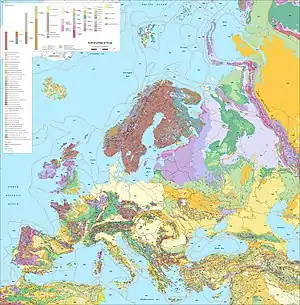Tisza Plate
The Tisza Plate is a tectonic block, or microplate, in present-day Europe. The two major crustal blocks of the Pannonian Basin, Pelso and Tisza, underwent a complex process of rotation and extension of variable magnitude during the Cenozoic era. The northward push of the Adriatic Block initiated the eastward displacement and rotation of both the Alcapa (or Pelso) and Tisza blocks.[1][2][3] The Zágráb-Hernád line is the former plate margin between the Pelso of African origin and the Tisza Plate of Eurasian origin.

Pelso and Tisza units
References
- Tom McCann (2008). The Geology of Central Europe. Geological Society of London. p. 805. ISBN 978-1-86239-265-6.
- Petrology of the metamorphic basement of the Tisza Block at the Jánoshalma High, S Hungary, Acta Geologica Hungarica, p. 349-371, ISSN 0236-5278 (Print) ISSN 1588-2594 (Online)
- Luigi Beccaluva; Gianluca Bianchini; B. Marjorie Wilson; Marjorie Wilson (2007). Cenozoic Volcanism in the Mediterranean Area. Geological Society of America. p. 68. ISBN 978-0-8137-2418-8.
This article is issued from Wikipedia. The text is licensed under Creative Commons - Attribution - Sharealike. Additional terms may apply for the media files.

